This is the second part of this post. Click here to read Part 1.
1. Stance and Alignment
a. Line up in a 3 point or 4 point stance, with feet parallel to each other.
b. Shoulders parallel to the ground.
c. Head in natural extension so you can focus on your alignment and on either blockers to both sides.
d. Arms down from shoulder, fingers extended out.
e. Back flat, tail slightly up and knees bent so you are ready to uncoil.
f. Feet up under you with weight on finger tips and distributed equally on both feet.
g. Line up 12 – 18 inches off the ball (adjust according to assignment).
2. Keys
a. If aligned on an outside shade of either the center, guard, or tackle – key belt buckle of your alignment, near back, to quarterback.
Assignments
3. If aligned on Tackle, Guard, or Offset on Center
a. Explode on movement of ball. Explode and control, protect your linebacker.
b. Explode stepping with near foot mirroring the step of your alignment. Your goal on movement is to be in the same position you were in prior to the snap of the ball.
c. As you step, deliver a blow keeping your alignment away from your feet.
d. Separate and react.
4. If Aligned on Offensive Tackle as a 5 Technique
a. Protect “C” Gap.
b. Protect the linebacker. Control power, and off tackle trap.
c. Must squeeze all inside plays keeping your outside arm and leg free.
d. Versus option the 5 technique has nearback if offensive tackle blocks down. If offensive tackle blocks straight ahead or outside, 5 technique has “C” gap responsibility. Constrict “B” gap, control “C” gap. 5 technique has quarterback if he gets to “C” gap. Attack don’t slow play.
– If quarterback gives ball to dive, squeeze back to the ball.
e. Never get reached.
5. If Aligned as a 3 technique on the Guard
a. Protect “B” gap responsibility.
b. Key belt buckle of your guard and reaact to blocking scheme.
c. Squeeze all plays from “B” gap responsibility.
d. Pass rush in proper lane – gap responsibility.
6. If Aligned on Center (offset)
a. Protect “A” gap offset side responsibility.
b. Key center’s belt buckle. 1 technique must be in a position to play off an attempted reach block by center, but you must be able to keep center on the line of scrimmage if he tries to scoop for the backside linebacker. Close on the center and create a double team on you.
c. Never get reached.
d. If center gets off the line of scrimmage, you must make the tackle as you probably got the backside linebacker blocked.
e. If pass, rush gap responsibility.
Reactions

1. If Tackle base blocks or fires straight into you:
a. Explode – Deliver – Control Blocker. Keep shoulders square, ready to react either way.
b. Locate ball – Shed – Tackle
2. If Offensive Tackle turns out on you:

a. Fight pressure by maintaining outside leverage.
b. Keep shoulders square to the line of scrimmage and do not
fight inside too fast or ball carrier will bounce outside.
c. Squeeze tackle inside
3. If Offensive Tackle tries to reach block you:

a. Key tackles belt buckle. Use had shiver and keep your feet back.
b. Never allow offensive tackle to get his head outside you.
c. Keep outside leg free, slide to outside and keep shoulders square to the line of scrimmage.
d. Use inside arm, and use a pull under to outside shoulder of offensive tackle.
4. If Tight End and Tackle Double Team:

a. Must destroy the block of the offensive tackle.
b. Fight Tight Ends pressure by getting skinny in the hole and defeating the base block by the tackle.
c. Get Skinny as you drive through your “C” gap responsibility, split the double team.
d. Stay low -never stand up! – create a pile and don’t allow the Tight End to work off onto the linebacker.
e. If beaten consistently – drop to ground on offensive tackle.
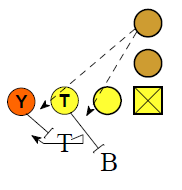
5. If Offensive Tackle Releases Inside:
a. It may be a cut off block on linebacker, a trap block or loaded situation. use your hand shiver while closing down. Don’t allow offensive tackle to release inside without squeezing him.
b. Keep your feet moving and don’t over penetrate any deeper that a yard and a half. Read angle and react.
c. Be conscious of down block by Tight End or Slot.
d. Always work to keep your outside arm and leg free.
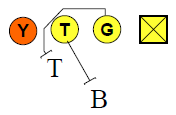
6. If Offensive Tackle Blocks Down and Guard Short Pulls:
a. Key tackles belt buckle and squeeze getting your hands on the down block.
b. Take your eyes to level one to see if guard pulls.
c. Play underneath the log or kickout block.
d. If no threat get your eyes to the near back.
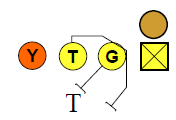
7. If Tackle Folds and Guard Comes Out:
a. Key belt buckle of your tackle for play reaction.
b. Tackles movement will take you to the guard on the fold block, squeeze and constrict through the neck of the guard.
c. Don’t allow ball carrier to bounce outside.
d. Must not get knocked back or off the line of scrimmage or take backside – Don’t go around the guard.
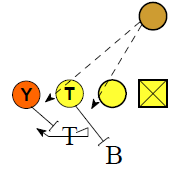
8. If Offensive Tackle Releases Inside:
a. It may be a cut off block on linebacker, a trap block or loaded situation. use your hand shiver while closing down. Don’t allow offensive tackle to release inside without squeezing him.
b. Keep your feet moving and don’t over penetrate any deeper that a yard and a half. Read angle and react.
c. Be conscious of down block by Tight End or Slot.
d. Always work to keep your outside arm and leg free.
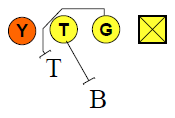
9. If Offensive Tackle Blocks Down and Guard Short Pulls:
a. Key tackles belt buckle and squeeze getting your hands on the down block.
b. Take your eyes to level one to see if guard pulls.
c. Play underneath the log or kickout block.
d. If no threat get your eyes to the near back.
About the Author of this post:
Jerry Campbell has over 30 years of high school and college coaching experience. He has experience as a head coach, offensive coordinator, and various position coaches. He has written numerous football coaching articles in various publications, is the author of over 30 books on coaching football, and has produced 12 coaching video series. Additionally, he is a nationally sought after speaker on the coaching clinic circuit.